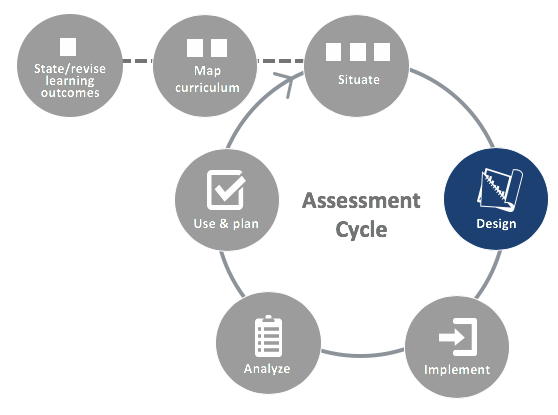Designing Assessment
Once learning goals/outcomes are defined and mapped to the curriculum, the next step is to determine how well students in your program have accomplished the program's learning goals/outcomes.

Steps:
1. Focus & articulate assessment questions: Which outcome/goal should be under focus? What do faculty want to know or curious about?
2. Determine evidence/indicators: What information/evidence needs to be gathered to answer the question? How will you know that students are meeting the stated outcomes/goals? What will be the most useful and meaningful information to have to inform program improvement?
3. Determine judgment criteria: What criteria are you going to use to determine program effectiveness or success?
4. Determine methods: How will you gather evidence? There are variety of methods and instruments that can be used to capture how students perform or develop as a result of your program. Student learning is a very complex construct/phenomenon and that it will likely take multiple methods to accurately unveil what students learned and to determine program effectiveness.
Assessment questions
Below are some example assessment questions.
- To what extent do our graduating students meet our program-level performance expectations?
- Are students sufficiently prepared sufficiently to take a thesis course? What research skills do we need to foster in the courses leading up to the thesis course?
- What career paths do students pursue and how is our degree program contributing to their success after graduation?
Methods Options
There are direct and indirect types of evidence-gathering methods in assessment. Direct evidence of student learning (i.e., student performance and products) provides demonstrations of what students know or can do with what they learned. Indirect evidence (i.e., student self-assessment, opinions, perceptions, attitudes) allows you to make inferences about student learning.
Direct evidence of student learning:
- Course-embedded assignments
- Course-embedded quizzes and exams
- Pre-post exams
- Capstone projects (thesis, creative projects, senior exhibits)
- (e-)portfolio
- Observation of student performance
- Student publications and professional presentations
- Licensure exams
- Standardized tests (e.g., Collegiate Learning Assessment, GRE subject tests)
Inirect evidence of student learning:
- Surveys (SONS, UCUES, career destination survey, exit survey, alumni survey, employer survey, mid-semsester and end-of-semester course surveys)
- Interviews
- Focus groups
- Institutional data (time to degree, graduation and retention data, etc.)
- Job placement and placement in higher degree programs
- Course-taking patterns
For more details on various methods options, go to the sub-menu under "design".
FAQs
"Aren't course grades sufficient to indicate student performance?"
Course grades are often a combination of various elements of expected performances in a course (including participation) and does not necessarily reflect how students performed a particular program-level goals/outcome.
